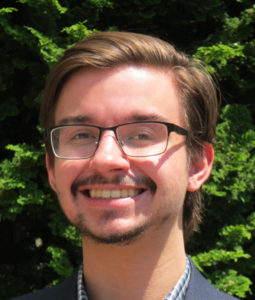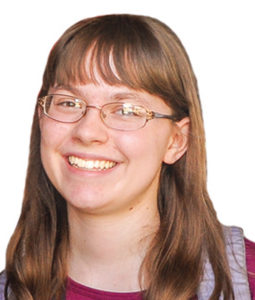Harvey Mudd Students Receive NIST-SURF Fellowships
April 18, 2018Two Harvey Mudd College students, Christopher Hoyt ’18 and Leah Stevenson ’19, have been honored by the National Institute of Standards and Technology’s Summer Undergraduate Research Fellowship (SURF). The NIST-SURF fellowship grants them an opportunity to spend a summer working alongside renowned NIST scientists in a national laboratory in Boulder, Colorado. They receive a $5,500 fellowship and a $3,600 stipend.
NIST is one of the world’s leading research organizations and home to four Nobel Prize winners. The fellowship selects approximately 150 undergraduate students from across the nation each year and gives them the chance to conduct research at one of the nation’s premier institutions. Hoyt and Stevenson will gain valuable hands-on experience and work with cutting-edge technology during their summer fellowships.
 Hoyt, a senior, is the president for the HMC chapter of the Society for Industrial and Applied Mathematics, and a grader for the Department of Mathematics. He is also the recipient of a 2016 Barry Goldwater Scholarship, and this is his second NIST Fellowship in Colorado.
Hoyt, a senior, is the president for the HMC chapter of the Society for Industrial and Applied Mathematics, and a grader for the Department of Mathematics. He is also the recipient of a 2016 Barry Goldwater Scholarship, and this is his second NIST Fellowship in Colorado.
During summer 2016, Hoyt conducted research in Colorado with Jeanne Quimby and the Metrology Wireless Group conducting measurements of wireless propagation channels using NIST’s robotic system in order to develop standards for the next generation of wireless cellular communications systems. He’s also done summer research with Dr. Sylvester and Dr. Rasmussen at the University of Wyoming in order to analyze the phenotypes of Maize mutants using various methods of microscopy.
Working with NIST program scientist Stephen Russek this summer, Hoyt will investigate artificial intelligence for magnetic resonance imaging (MRI). The opportunity involves the development and evaluation of deep learning image reconstruction for MRI and the processing of these images to segment and phenotype synthetic tumors and lesions. In addition to coding in TensorFlow and AUTOMAP, Hoyt will use the NIST preclinical MRI system to obtain precise raw data sets to evaluate image reconstruction methods and will use 3-D printed anatomically correct phantoms with realistic lesions to test segmentation and phenotyping.
“I’m really excited to participate in the NIST program once again,” Hoyt says. “I had a lot of fun doing the program before, and the SURF program gives me many chances to explore a lot of new material beyond my major in mathematics. Plus, Boulder is a really nice town, and I’m glad that I get the chance to spend another summer there.”
 Stevenson is a junior majoring in chemistry. During her summer NIST Fellowship, she will explore the development of novel alternative fuels with Thomas J. Bruno, group leader of the Experimental Properties of Fluids Group of the Applied Chemicals and Materials Division. She will study the phase properties of biofuels via NIST’s composition-explicit distillation curve, a technique that provides an energy content channel in addition to the volatility of a fuel. Stevenson will have the opportunity to become an expert at gas chromatography, mass spectrometry and many other analytical techniques.
Stevenson is a junior majoring in chemistry. During her summer NIST Fellowship, she will explore the development of novel alternative fuels with Thomas J. Bruno, group leader of the Experimental Properties of Fluids Group of the Applied Chemicals and Materials Division. She will study the phase properties of biofuels via NIST’s composition-explicit distillation curve, a technique that provides an energy content channel in addition to the volatility of a fuel. Stevenson will have the opportunity to become an expert at gas chromatography, mass spectrometry and many other analytical techniques.
During summer 2017, Stevenson worked with Dr. John Cort at Pacific Northwest National Laboratory to improve the characterization of complex bio-oil mixtures using heteronuclear NMR spectroscopy. “The conversion of biomass into liquid fuels is of interest as a source of sustainable energy, and it is important to understand the chemical composition of these mixtures and the effects of their composition on properties relevant to their use as fuels,” says Stevenson. “NMR spectroscopy is a powerful tool for elucidation of the components of bio-oils and their chemical structures. I collected, processed and analyzed HSQC NMR spectra of bio-oils as well as possible components. I developed and implemented an algorithm in Python to match the spectra of the components with features in the bio-oil spectra so that individual molecular components could be distinguished.”
Her research at Harvey Mudd with professors Gerald Van Hecke ’61 and Kerry Karukstis involves studying the self-assembly process of chromonic molecules, a class of soluble aromatic compounds that stack via intermolecular interactions to form column-like aggregates in solution. Stevenson uses static light scattering in conjunction with refractive index measurements and fluorescence spectroscopy to learn more about this stacking process in chromonic systems.
At Harvey Mudd, Stevenson is a chemistry tutor for Academic Excellence, a musician in The Claremont Colleges Orchestra, and is part of The Claremont Colleges Library Board of Student Stakeholders. She’s also a recipient of the Department of Chemistry’s William G. Sly Prize, which recognizes her curiosity, intellectual integrity and enthusiasm for chemistry.
Stevenson says her goal is to obtain a PhD in physical chemistry and pursue a career in basic chemical research.
A recipient of the National Science Foundation’s prestigious Award for the Integration of Research and Education, Harvey Mudd College has long recognized the importance of collaborative student-faculty research, setting aside nearly $3 million annually for the purpose. HMC’s Summer Undergraduate Research Program typically involves up to 200 student researchers. The NIST Fellowships directly benefit undergraduate research, a program that is central to the College and is a high priority for funding within the College’s current comprehensive $150 million campaign.
